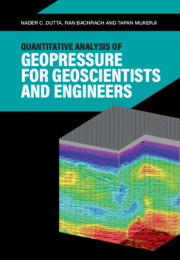Book contents
- Quantitative Analysis of Geopressure for Geoscientists and Engineers
- Quantitative Analysis of Geopressure for Geoscientists and Engineers
- Copyright page
- Contents
- Preface
- 1 Basic Pressure Concepts and Definitions
- 2 Basic Continuum Mechanics and Its Relevance to Geopressure
- 3 Mechanisms of Geopressure
- 4 Quantitative Geopressure Analysis Methods
- 5 Seismic Methods to Predict and Detect Geopressure
- 6 Integrating Seismic Imaging, Rock Physics, and Geopressure
- 7 Methods for Pore Pressure Detection
- 8 Gravity and EM Field Methods Aiding Pore Pressure Prediction
- 9 Geopressure Detection and Prediction in Real Time
- 10 Geopressure Prediction Using Basin History Modeling
- 11 Geohazard Prediction and Detection
- 12 Petroleum Geomechanics and the Role of Geopressure
- 13 Guidelines for Best Practices
- 14 Recent Advances in Geopressure Prediction and Detection Technology and the Road Ahead
- Book part
- References
- Index
1 - Basic Pressure Concepts and Definitions
Published online by Cambridge University Press: 10 February 2021
- Quantitative Analysis of Geopressure for Geoscientists and Engineers
- Quantitative Analysis of Geopressure for Geoscientists and Engineers
- Copyright page
- Contents
- Preface
- 1 Basic Pressure Concepts and Definitions
- 2 Basic Continuum Mechanics and Its Relevance to Geopressure
- 3 Mechanisms of Geopressure
- 4 Quantitative Geopressure Analysis Methods
- 5 Seismic Methods to Predict and Detect Geopressure
- 6 Integrating Seismic Imaging, Rock Physics, and Geopressure
- 7 Methods for Pore Pressure Detection
- 8 Gravity and EM Field Methods Aiding Pore Pressure Prediction
- 9 Geopressure Detection and Prediction in Real Time
- 10 Geopressure Prediction Using Basin History Modeling
- 11 Geohazard Prediction and Detection
- 12 Petroleum Geomechanics and the Role of Geopressure
- 13 Guidelines for Best Practices
- 14 Recent Advances in Geopressure Prediction and Detection Technology and the Road Ahead
- Book part
- References
- Index
Summary
This chapter introduces the basic concepts used for understanding formation pore pressures, such as pressure gradients, lithostatic and hydrostatic pressure, and effective vertical stress. Terzaghi's law is defined. The various units used for pore pressure are defined. The importance of understanding pore pressure and various applications for exploration, drilling safety, and prediction of environmental hazards are explained.
Keywords
- Type
- Chapter
- Information
- Publisher: Cambridge University PressPrint publication year: 2021
- 1
- Cited by

